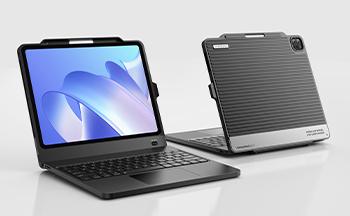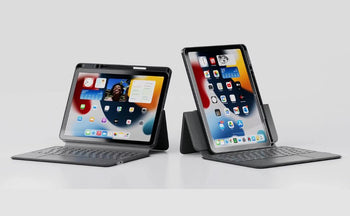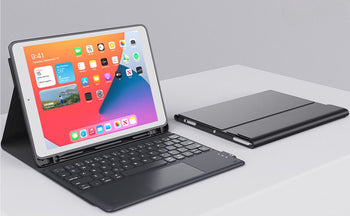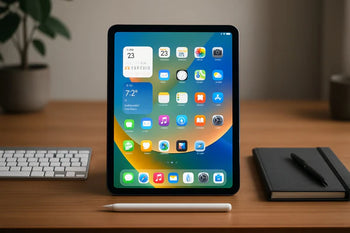That “iPad is Disabled, Connect to iTunes” message? Yeah, it’s a pain—but honestly, the fix isn’t as complicated as it looks. You can usually get back in by putting your iPad into recovery mode and connecting it to iTunes or Finder on your computer. This’ll wipe your device, but if you’ve got a backup somewhere, you can set it up again without losing everything.
Most of the time, this happens after too many wrong passcode tries. Apple’s just trying to keep your stuff safe. But before you jump into a full restore, it’s worth checking a few simple things that might save you the hassle.
Let’s break down why your iPad locked itself, what you can try before plugging it into iTunes, and the exact steps to restore it if you have to. With a little patience, you’ll get your iPad working again—and hopefully avoid this mess next time.
Keep your iPad safe from drops and accidents that could lock you out. Explore our Rugged iPad Cases for ultimate protection.
Why Your iPad Says Disabled Connect to iTunes

Usually, a disabled iPad means something’s up with your passcode, maybe a recent update went sideways, or there’s a deeper software hiccup. The device locks itself to keep your info safe, and often the only way forward is to connect it to iTunes or Finder for recovery.
Too Many Wrong Passcode Attempts
If you keep punching in the wrong passcode, the iPad will lock itself. That’s Apple’s way of stopping anyone from guessing their way in. At first, it’s just a short lockout, but after enough failed tries, you’ll see “iPad is disabled, connect to iTunes.”
Once you hit this point, you can’t unlock it without a computer. Connecting to iTunes (on Windows or older Macs) or Finder (on newer Macs) lets you update or restore the device. If you’ve backed up to iCloud or your computer, you can get your data back after restoring.
Without a backup, though, restoring wipes everything. There’s really no way around the passcode at that point—you’ll lose your data.
Security Lockout After Updates
Sometimes, a failed or interrupted iOS update can leave your iPad disabled. Maybe the battery died, your Wi-Fi dropped, or something glitched during the process. Instead of booting up, it just shows the connect to iTunes screen.
Here, it’s not about the passcode—it’s software corruption. The iPad can’t load the system, so you’ll need recovery mode.
When you connect to iTunes or Finder, you’ll usually get two choices: Update (which tries to keep your data) or Restore (which erases everything). Try Update first. If that doesn’t work, you’ll have to Restore.
Other Software or Sync Issues
Sometimes, the disabled screen pops up because of syncing problems or other software errors. Corrupted files, storage issues, or even a failed app install can trigger it.
On rare occasions, the iPad fails a security check with Apple’s servers and gets forced into recovery mode. This shows up more on older devices or if you’re running outdated iTunes.
To fix it, connect your iPad to a computer and run recovery. Make sure iTunes or Finder is up to date. Using the latest version just makes life easier and helps avoid weird errors.
Want style and security in one? Discover our Luxury iPad Cases designed to protect your device while looking premium.
Quick Fixes Before Using iTunes

You might not need to jump right to a full restore. Sometimes, just waiting, restarting, or checking your hardware can save you from losing data or wasting time.
Wait for the Lockout Timer to End
If you’ve entered the wrong passcode too much, your iPad locks for a set time. The first lockout is short—maybe a minute—but it gets longer each time. After ten failed tries, it’s fully disabled.
When you see the timer, stop guessing. Wait it out. Once the countdown ends, try again if you actually remember the passcode.
If you can’t remember it, waiting won’t help. Eventually, you’ll need to reset the device. But if you just mistyped, taking a breather might save you from a full wipe.
Restart or Force Restart Your iPad
Sometimes, a simple restart clears up temporary glitches that make the disabled message show up when it shouldn’t. Hold the power button until the slider appears, turn it off, then power it back on after a few seconds.
If the screen’s frozen, you’ll need a force restart. Here’s how:
- With Home button: Hold both the Home and Top buttons until you see the Apple logo.
- Without Home button: Quickly press Volume Up, then Volume Down, then hold the Top button until the Apple logo appears.
This won’t erase anything. It just refreshes the system and sometimes clears up whatever’s causing the disabled state.
Check for Cable and Port Issues
Once in a while, the disabled message is really about a bad connection to your computer. If iTunes or Finder can’t see your device, check the cable and charging port.
Look for dust, lint, or damage inside the port. Use a soft brush or a bit of compressed air—don’t go poking around with sharp stuff.
Try a different Apple-certified cable and another USB port. Cheap or damaged cables fail a lot during recovery. If you can, try a second computer to see if the problem’s your iPad or your hardware.
Restoring Access Through iTunes or Finder
Most of the time, you can get back in by putting your iPad into recovery mode and restoring it with iTunes or Finder. This will erase everything, but you can recover your data if you’ve got a backup somewhere.
Enter Recovery Mode on Your iPad
Recovery mode lets your computer talk to your iPad even if it’s locked or disabled. The steps are a little different depending on whether your iPad has a Home button.
For iPads with a Home button:
- Turn off the iPad.
- Hold the Home button while plugging it into your computer.
- Keep holding until you see the recovery mode screen.
For iPads without a Home button:
- Connect the iPad to your computer.
- Press and hold the Top button and a volume button until the power slider shows up.
- Slide to power off, then hold the Top button until you see recovery mode.
If you see just the Apple logo, not the recovery screen, try again. Timing matters—hold the buttons until the right screen pops up.
Use iTunes or Finder to Restore Device
Once you’re in recovery mode, your computer should spot the iPad. On macOS Catalina or later, open Finder. On macOS Mojave or earlier or Windows, use iTunes.
A prompt should pop up with options to Update or Restore. Pick Restore. That’ll erase your iPad, remove the passcode, and install the latest iPadOS.
If the download takes more than 15 minutes, your iPad might exit recovery mode. If that happens, just repeat the steps to get back in.
Make sure your internet’s solid—the download can be several gigabytes. And honestly, using the original Apple cable avoids a lot of weird problems.
Restore From a Backup or Set Up as New
When the restore finishes, you’ll get a few setup options:
- Restore from iTunes backup: If you’ve synced before, pick your backup to get your stuff back.
- Restore from iCloud: Sign in with your Apple ID to grab your iCloud backup.
- Set up as new: If there’s no backup, you’ll have to start from scratch.
Restoring from backup is obviously the best way to get your contacts, messages, and apps back. If there’s no recent backup, you’ll lose some things—so yeah, backing up regularly is worth it.
When to Seek Professional Help
If your computer still can’t detect the iPad, or you keep seeing errors, it might be time to get help. Stuff like a busted charging port or broken buttons can make recovery mode impossible.
Apple Support or authorized repair shops can run diagnostics and might be able to recover data if you’ve got backups. Some third-party shops can help too, but make sure they know what they’re doing with iOS devices.
If you restore over and over and keep getting locked out, there’s probably a deeper problem—hardware or software—that needs an expert.
Make your iPad more productive and secure with a Magnetic iPad Case with Keyboard. Perfect for work, study, or travel.
Conclusion: iPad Disabled Connect to iTunes
Dealing with the “iPad disabled connect to iTunes” message can feel overwhelming, but in most cases, the issue comes down to too many failed passcode attempts or a simple software hiccup. Thankfully, with the right steps, you can get your device working again.
Whether you try waiting out the lockout, restarting, or restoring through iTunes or Finder, there’s usually a way forward. If nothing works, professional repair may be the safest option.
Want to troubleshoot another common iPad issue? Read our guide on how to fix an iPad stuck on the Apple logo.
Frequently Asked Questions: iPad Disabled Connect to iTunes
You can fix a disabled iPad by using recovery mode with iTunes or Finder, or by erasing it through iCloud if Find My iPad was enabled. Sometimes you’ll need to restore the whole device, which deletes all your data unless you’ve got a backup.
How to unlock a disabled iPad that says connect to iTunes?
Plug your iPad into a computer with iTunes or Finder. Put it into recovery mode using the right button combo for your model. When the recovery screen pops up, choose Restore to erase the device and set it up again.
How to reset a disabled iPad without iTunes?
If you set up Find My iPad, go to iCloud.com and log in. Pick your device from the list and hit Erase iPad. Afterward, you can restore from an iCloud backup or start fresh.
How do I get rid of disabled connect to iTunes?
You’ll have to erase the device using iTunes, Finder, or iCloud. There’s no way to remove the disabled screen without wiping the iPad. After erasing, restore from backup if you have one.
How do I undisable a permanently disabled iPad?
If your iPad's permanently disabled, you'll need to restore it with recovery mode. Just connect it to your computer, open iTunes or Finder, and hit Restore when it pops up. If that doesn't work out, you might want to reach out to Apple Support for some extra help.



















